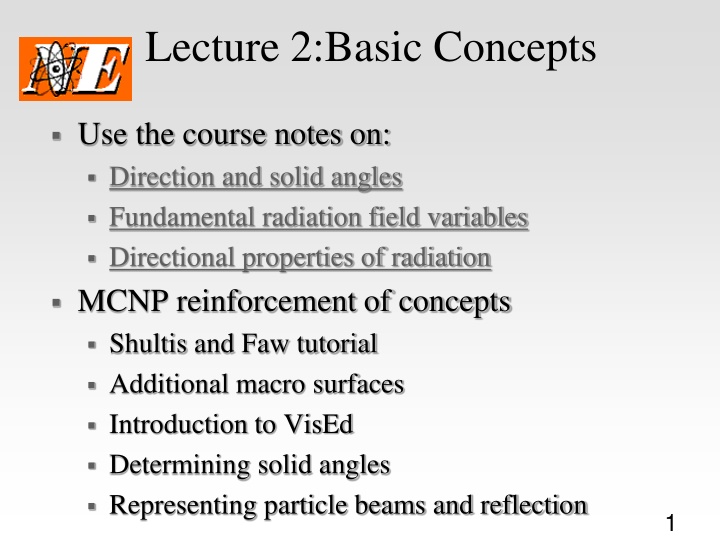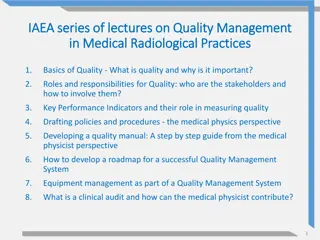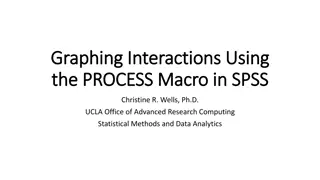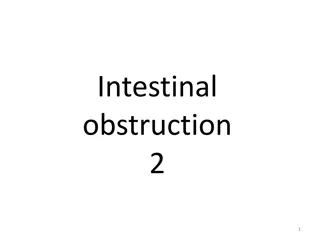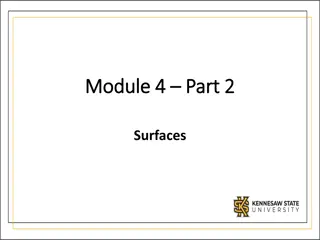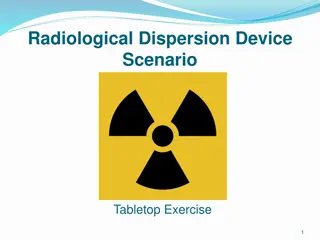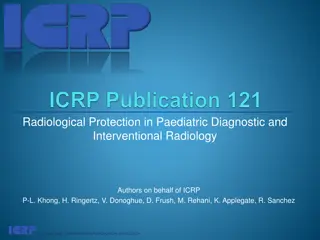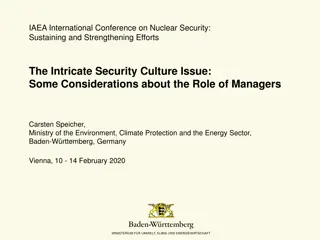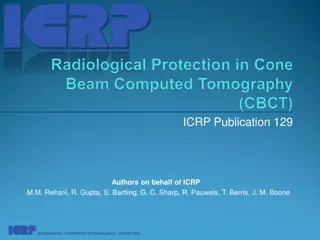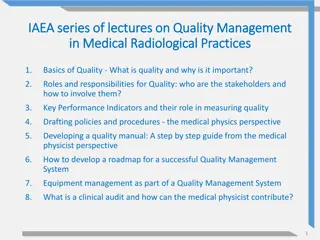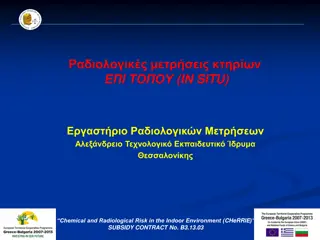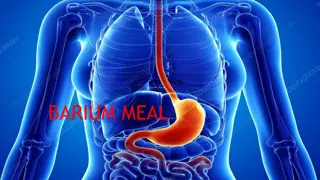Radiological Concepts and Macro Surfaces Overview
Explore basic concepts in radiation science such as direction, solid angles, field variables, and directional properties along with practical applications in modeling macro surfaces like spheres, cylinders, cones, and tori. Use resources like course notes, Shultis and Faw tutorials, and MCNP for reinforcement. Dive into determining solid angles, representing particle beams, and reflections for a comprehensive understanding.
Download Presentation

Please find below an Image/Link to download the presentation.
The content on the website is provided AS IS for your information and personal use only. It may not be sold, licensed, or shared on other websites without obtaining consent from the author.If you encounter any issues during the download, it is possible that the publisher has removed the file from their server.
You are allowed to download the files provided on this website for personal or commercial use, subject to the condition that they are used lawfully. All files are the property of their respective owners.
The content on the website is provided AS IS for your information and personal use only. It may not be sold, licensed, or shared on other websites without obtaining consent from the author.
E N D
Presentation Transcript
Lecture 2:Basic Concepts Use the course notes on: Direction and solid angles Fundamental radiation field variables Directional properties of radiation MCNP reinforcement of concepts Shultis and Faw tutorial Additional macro surfaces Introduction to VisEd Determining solid angles Representing particle beams and reflection 1
Shultis and Faw tutorial In the course Public area Same authors as our textbook 2
Additional macro surfaces We will build on the SPH (sphere) that we learned last week by adding RPP (rectangular parallelpiped = box) RCC (right circular cylinder) TRC (truncated cone) TX, TY, and TZ (torus) 3
Macro Boxes: RPP RPP # surf min x max x min y max y z z Syntax: Description: Rectangular parallelpided surface with dimensions: Xmin,Xmax Xrange Ymin,Ymax Yrange Zmin,Zmax Zrange Surface numbers: .1 +x .2 x .3 +y .4 y .5 +z .6 z min max 4
Macro Spheres: SPH x y z R SPH # surf Syntax: ( ) z , Description: General sphere, centered on with radius R Surface numbers (none needed. Just one surface.) , x y 5
Macro Cylinders: RCC RCC Syntax: Description: Right circular cylinder surface with dimensions Vx, Vy, Vz Coordinates of center of base Hx,Hy,Hz Vector of axis R radius # surf V V V H H H R x y z x y z Surface numbers: .1 +r (curved boundary) .2 End of H (usually the top) .3 Beginning of H (usually the bottom) 6
Macro Cones: TRC TRC # surf V V V H H H R R Syntax: Description: Truncated right cone Vx, Vy, Vz Coordinates of center of base Hx,Hy,Hz Vector of axis R1 radius of base R2 radius of top Surface numbers: .1 +r (curved boundary) .2 End of H (usually the top) .3 Beginning of H (usually the bottom) 1 2 x y z x y z MCNP5 Manual Page: 3-19 7
Torus: TX or TY or TZ Syntax: TZ # surf C C C R minor r minor r Major x y z The TZ is for a donut lying on a table. If you are setting it on edge (i.e., like a wheel ready to roll), the axis (i.e., axle of the wheel) must be the x-axis (TX) or y-axis (TY) Description: Truncated right cone Cx,Cy,Cz Coordinates of absolute center (in the center of the hole at of the thickness of donut) Rmajor Radius of the circle that goes from the center to the mid-circle of the tube of the donut (It would be the radius if the whole torus were reduced to a simple circle=infinitely thin donut) rminor Radius of the tube of the donut 8
Other 9
Other (2) 10
VisEd Cheat Sheet 1. Start VisEd. 2. File->Open (Do not modify input) to choose and open the input file 3. Click Color in both windows 4. Zoom in OR Zoom out to get them right 5. As desired: 1. Click Cell or Surf to see cell numbers 2. Click Origin to make the window sensitive to subsequent clicks (in either window) 3. Insert origin coordinates to move around 11
VisEd example Inside a box (100x100x100) Torus of Rmajor=20, Rminor=5 on floor Cylinder of radius 20, ht 40 on top of torus Sphere of radius 10 centered in cylinder 12
Determining solid angles The determination of solid angles using MCNP is very straightforward, once you get oriented: The eye point is replaced with an isotropic point source (energy or particle type doesn t matter) The surface(s) that you want the solid angle calculated for is modeled as part of a 3D cell (and checked with VisEd, if desired). The entire geometry is filled with void (mat#=0) The tally is a surface crossing tally (F1:n or F1:p) To figure out the answer, you need to notice whether the particles will cross the surface once (e.g., top of cylinder or one face of RPP) or twice (e.g., sphere) 13
Solid Angle Examples Disk of radius 1 from 10 above Sphere of radius 2 from 20 above center Torus (Rmajor=10, Rminor=2) from 20 cm above its center 14
HW 1.1 Use a hand calculation to compute the solid angle subtended by a sphere of radius 5 cm whose center is 25 cm from the point of view Check your calculation with an MCNP calculation (within 0.1% error) 15
HW 1.2 Use a hand calculation to compute the solid angle subtended by a torus (lying flat on the floor) with major radius 10 cm and minor radius of 1 cm, as viewed from the point 20 cm above the floor. Check your calculation with an MCNP calculation (within 0.1% error) 16
HW 1.3 Use a hand calculation to calculate both the average flux and the average current on a 5 cm radius disk lying on the z=0 plane, centered on the origin. For the source use a point isotropic 2 MeV neutron source located at (0,0,10). Assume void material fills an enclosing sphere of radius 30 cm (centered on the origin). Check your calculation with an MCNP calculation (within 0.1% error) 17
